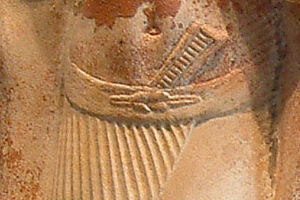Knot (hieroglyph) on:
[Wikipedia]
[Google]
[Amazon]
 The ancient Egyptian knot hieroglyph, or ''girdle knot'', Gardiner sign listed no. S24, portrays a
The ancient Egyptian knot hieroglyph, or ''girdle knot'', Gardiner sign listed no. S24, portrays a
V13:S24:O34-.-V13:O34:O34-S24 It is used as the S24:X1*Z1-.-S24:Z1-.-S24:O34-Z7:D40-.-S24:O34-G43-F41 for meanings of: knot, tie, ligature, backbone, vertebrae, spine, etc.
File:Egyptcones KM.JPG,
 The ancient Egyptian knot hieroglyph, or ''girdle knot'', Gardiner sign listed no. S24, portrays a
The ancient Egyptian knot hieroglyph, or ''girdle knot'', Gardiner sign listed no. S24, portrays a reef knot
The reef knot, or square knot, is an ancient and simple binding knot used to secure a rope or line around an object. It is sometimes also referred to as a Hercules knot. The knot is formed by tying a left-handed overhand knot between two ends, ...
. Besides its use as a hieroglyph
A hieroglyph ( Greek for "sacred carvings") was a character of the ancient Egyptian writing system. Logographic scripts that are pictographic in form in a way reminiscent of ancient Egyptian are also sometimes called "hieroglyphs". In Neoplatoni ...
, it has usage in statuary and reliefs. The knot hieroglyph is also an amulet, typically made of worked stone, or as jewellery elements.
Language usage
The knot hieroglyph is used in theEgyptian language
The Egyptian language or Ancient Egyptian ( ) is a dead Afro-Asiatic language that was spoken in ancient Egypt. It is known today from a large corpus of surviving texts which were made accessible to the modern world following the decipher ...
as the verb, ''(th)s, (th)ss'', for to knot, to tie, to tie together, etc.phonogram
Phonogram may refer to:
* A sound recording – see Geneva Phonograms Convention
* ''Phonogram'' (comics), a comic book by Kieron Gillen and Jamie McKelvie
* Phonogram (linguistics), a grapheme which represents a phoneme or a combination of phone ...
for ''(th)s'', as well as the determinative
A determinative, also known as a taxogram or semagram, is an ideogram used to mark semantic categories of words in logographic scripts which helps to disambiguate interpretation. They have no direct counterpart in spoken language, though they may ...
. There are many alternate spellings.
For the noun, it is Egyptian language ''(th)s, (th)s.t'', In jewellery and decoration
The knot used as an article of jewellery was especially known in the Middle Kingdom. It can be found in necklaces (see gallery photo), and as a small brooch. In ''Amulets of Ancient Egypt,'' a two-part, hollowgold
Gold is a chemical element with the symbol Au (from la, aurum) and atomic number 79. This makes it one of the higher atomic number elements that occur naturally. It is a bright, slightly orange-yellow, dense, soft, malleable, and ductile me ...
piece is shown, with a detailed rope-detailed fiber; it is made with a tongue and groove closure for the parts.Andrews, 1994. p. 44, plate 49b.
Gallery
Funerary cone
Funerary cones were small cones made from clay that were used in ancient Egypt, almost exclusively in the Theban Necropolis. The items were placed over the entrance of the chapel of a tomb. Early examples have been found from the Eleventh Dynasty ...
using the 'girdle-knot hieroglyph'
File:Tresor-dahchour-sesostris3-8.jpg, Small bandlet made of 16 knot-pieces
File:Nuovo_regno, XVIII_dinastia, regno_di_hatshepsut, rilievo, 1479-1457 ac ca., da tebe.JPG, Relief from reign of Hatshepsut
Hatshepsut (; also Hatchepsut; Egyptian: '' ḥꜣt- špswt'' "Foremost of Noble Ladies"; or Hatasu c. 1507–1458 BC) was the fifth pharaoh of the Eighteenth Dynasty of Egypt. She was the second historically confirmed female pharaoh, af ...
See also
* Gardiner's Sign List#S. Crowns, Dress, Staves, etc. *List of Egyptian hieroglyphs
The total number of distinct Egyptian hieroglyphs increased over time from several hundred in the Middle Kingdom to several thousand during the Ptolemaic Kingdom.
In 1928/1929 Alan Gardiner published an overview of hieroglyphs, Gardiner's sign ...
* Square knot
* Girdle of Isis
References
* Andrews, Carol, 1994. ''Amulets of Ancient Egypt,'' chapter 4: ''Scarabs for the living and funerary scarabs,'' pp 50–59, Andrews, Carol, c 1993, University of Texas Press, 518 amulets, 1, or multiples included in 12 necklaces; (softcover, ) *Budge. ''An Egyptian Hieroglyphic Dictionary,'' E.A.Wallace Budge, (Dover Publications), c 1978, (c 1920), Dover edition, 1978. (In two volumes, 1314 pp, and cliv-(154) pp.) (softcover, ) Egyptian hieroglyphs: crowns-dress-staves {{hieroglyph-stub